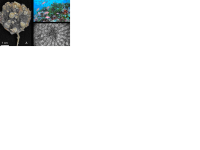
Port-Cros
Flore marine
Two bryozoan facies typical of the coralligenous habitat were studied at Port-Cros Archipelago. Both exhibited notable species richness with a small number of quantitatively dominant species (a Schizomavella species top-ranked in both cases), but were strikingly different in species composition, size and life-history of colonies, and in the identity and relative part of the higher taxa co-occurring with the bryozoans. The first facies covered rocky and biogenic walls; it was sampled by photo-quadrats at six sites. Bryozoans, sponges and macroalgae were clearly dominant over the other groups, with a hierarchical order depending on site features (rocky walls vs. bioherm edifice). Colonies of the eight most abundant species (1st ranked: S. mamillata) in terms of percent cover of walls are long-lived, large and, in most cases, highly calcified and massive. The second bryozoan facies consists in a species-rich assemblage established on leaves of Flabellia petiolata, with a particular concentration on the shaded side of leaves and a very low contribution of other higher taxa. All bryozoan species, and especially the five dominant ones (1st ranked: Schizomavella halimedae), were short-lived with single-layered, early fertile colonies, thus well adapted to life on a flexible, non-perennial substratum. Thus, these two bryozoan facies illustrate the diversity of the contribution of bryozoans to the coralligenous biodiversity.
| Authors | Jean-Georges HARMELIN |
|---|---|
| Editor | Parc national de Port-Cros |
| Number of pages | 18 |
| Reference | Sci. Rep. Port-Cros natl. Park, 31: 105-123 (2017) |

